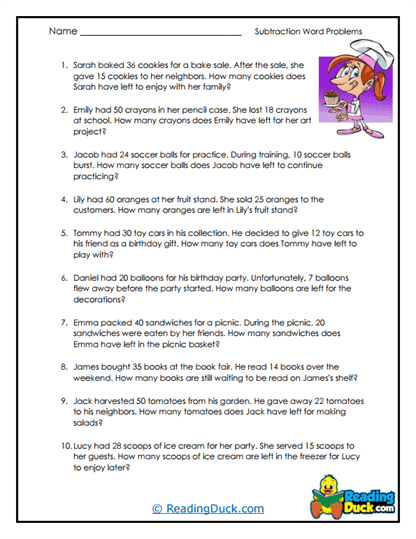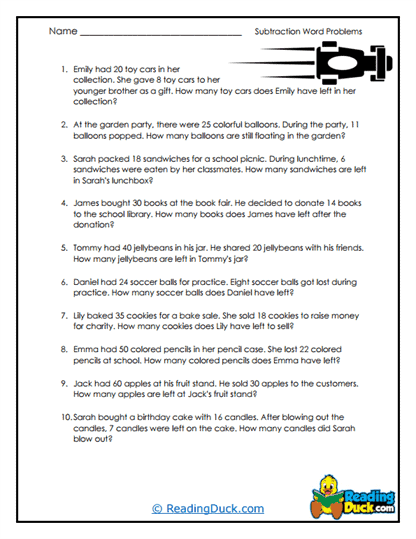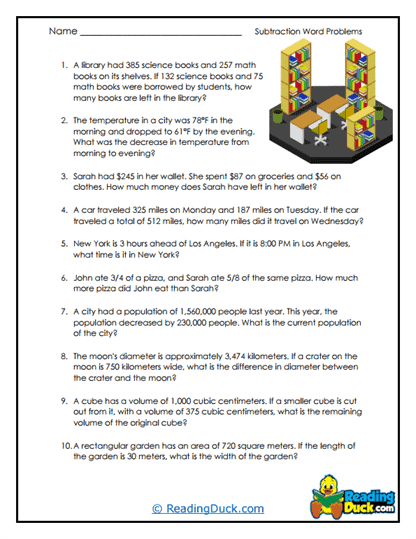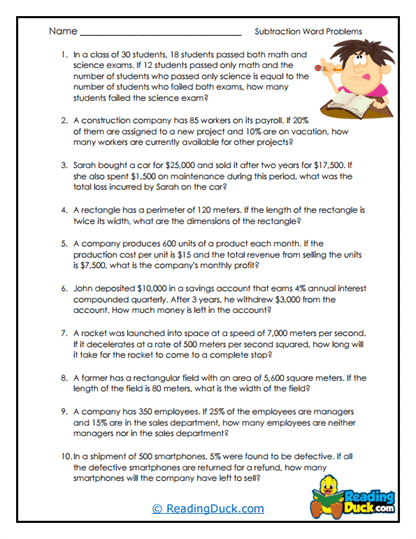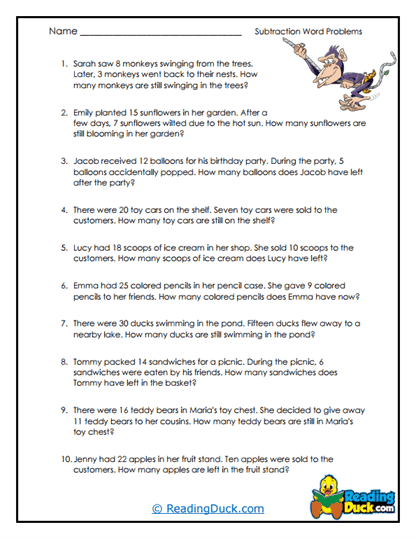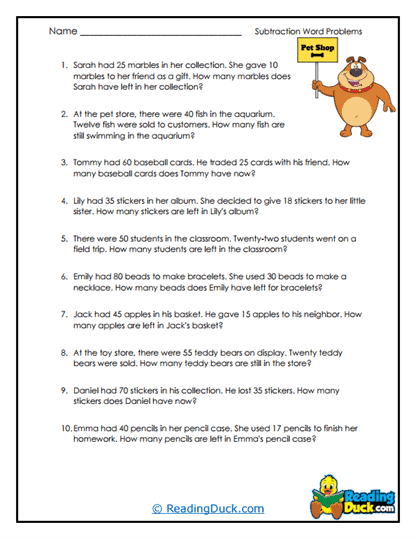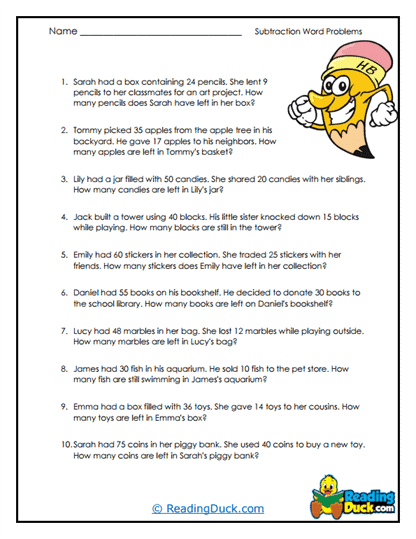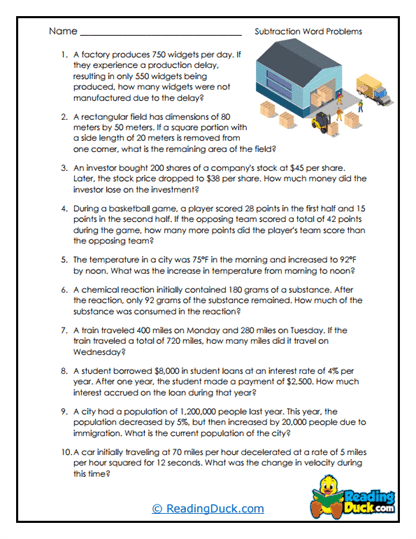Subtraction Word Problems Worksheets
About Our Subtraction Word Problem Worksheets
Our collection of Subtraction Word Problem worksheets offers students an engaging and practical way to master subtraction through real-life scenarios. This collection, which falls under the broader category of Math: Word Problems, is designed to help students apply subtraction in various contexts, enhancing their problem-solving skills and mathematical understanding. Each worksheet set is thoughtfully crafted to not only reinforce subtraction concepts but also to build reading comprehension and critical thinking abilities.
Each worksheet set includes:
- Multiple Choice Questions: These questions assess students' understanding of the reading passage by providing several answer options. This format helps reinforce key subtraction concepts and ensures students grasp the scenario presented in the problem.
- Short Answer Questions: In this section, students are encouraged to write their own answers, which allows them to express their thought processes and solidify their understanding of how to approach subtraction word problems.
- Open-Ended Questions: These questions prompt students to offer personal input, opinions, or reflections related to the scenarios in the word problems. This format fosters a deeper connection to the material by encouraging students to relate mathematical concepts to their own experiences.
Each worksheet includes an answer key, making it easy for teachers and parents to review and assess students' work. All of the worksheets are available as PDF files, which can be easily viewed electronically, downloaded, and printed out for classroom or homeschool use.
Understanding Subtraction: The Building Block of Basic Arithmetic
Subtraction is one of the four fundamental operations in arithmetic, often referred to as "taking away." It plays a crucial role in a child's early mathematical development, providing the foundation for more complex mathematical concepts and operations. When introducing subtraction to students, it's important to present the concept in a clear, relatable, and engaging way that connects math to real-life situations.
What Is Subtraction?
Subtraction is the process of determining the difference between two numbers by taking one number away from another. It is commonly used in situations where we need to find out how much is left after something is removed, how much more is needed, or the difference between two quantities. The basic subtraction equation is written as:
a−b=ca - b = c
Where:
- aa is the minuend, or the number you start with.
- bb is the subtrahend, or the number you take away.
- cc is the difference, or the result of the subtraction.
For example, if you have 10 apples and you give away 3, the subtraction problem is 10−3=710 - 3 = 7, leaving you with 7 apples.
Why Is Subtraction Important?
- Real-World Applications: Subtraction is used in countless real-life situations, from managing finances and making purchases to measuring distances and comparing quantities. Understanding subtraction helps students navigate everyday tasks and make informed decisions.
- Building a Foundation for Advanced Math: Mastery of subtraction is essential for understanding more complex mathematical operations such as division, fractions, and algebra. Subtraction is also a key component in solving word problems, making it a critical skill for academic success.
- Enhancing Problem-Solving Skills: Solving subtraction word problems requires students to think critically and apply mathematical reasoning. They must analyze the information given, identify the operation needed, and use subtraction to find the solution. This process enhances their problem-solving skills, which are valuable in both academic and real-world contexts.
Key Concepts in Subtraction Word Problems
- Understanding the Subtraction Process: Students must first understand the basic concept of subtraction, which involves identifying the minuend and the subtrahend in a problem. This foundational knowledge is crucial for accurately solving subtraction word problems.
- Recognizing Clue Words: Word problems often contain clue words that indicate subtraction is required, such as "left," "remain," "difference," "take away," or "decreased by." Teaching students to recognize these clues helps them determine when subtraction is the appropriate operation to use.
- Setting Up the Problem: Once students identify that subtraction is needed, they must set up the problem correctly by placing the larger number (minuend) first and subtracting the smaller number (subtrahend). This step is vital for ensuring accurate results.
- Interpreting the Results: After solving the subtraction problem, students must interpret the result within the context of the problem. This might involve understanding how much of something is left, how many more are needed, or the difference between two quantities.
Common Scenarios in Subtraction Word Problems
- Shopping and Finances: Word problems might involve scenarios where students need to calculate the change received after a purchase, determine how much money is left after spending, or compare the prices of two items.
- Measurement and Distance: Some word problems require students to subtract measurements, such as finding the difference in height between two objects, the remaining distance to a destination, or the amount of material left after cutting.
- Time and Scheduling: Subtraction is also used in problems involving time, such as calculating the time left before an event, determining the duration of an activity, or figuring out how much time has passed between two events.
Teaching Subtraction Through Word Problems
1. Presenting Subtraction in Real-Life Contexts
- Practical Math Activities: Encourage students to apply subtraction in real-life scenarios, such as calculating the change from a purchase, determining how many items are left after some are given away, or figuring out the difference in age between two people. These activities help students see the relevance of subtraction in everyday life.
- Cross-Curricular Connections: Use subtraction word problems to connect math with other subjects, such as science, geography, or history. For example, students can explore the concept of subtraction by analyzing population changes over time, comparing distances on a map, or calculating the difference in temperatures. This approach reinforces mathematical concepts while showing students how math is interconnected with other areas of knowledge.
2. Group Activities and Collaborative Learning
- Pair Work: Have students work in pairs to solve subtraction word problems. One student can read the problem aloud while the other writes down the subtraction equation and solves it. Then they can switch roles. This collaborative approach encourages communication, teamwork, and allows students to learn from each other's problem-solving strategies.
- Math Centers: Set up a math center in your classroom where students can work on subtraction word problems independently or in small groups. Provide manipulatives like counters, number lines, and subtraction flashcards to help them visualize and solve the problems. This hands-on approach is particularly beneficial for visual and kinesthetic learners who need to see and manipulate objects to understand subtraction.
3. Real-Life Projects and Applications
- Subtraction in Daily Life: Have students create a project where they track their daily activities involving subtraction, such as keeping a record of money spent and change received, tracking the number of pages read from a book, or calculating the time left before an event. This project helps students see the relevance of subtraction in their daily lives and understand how subtraction is used in various contexts.
- Field Trip Subtraction: If you take your students on a field trip, incorporate subtraction word problems related to the trip. For example, if you visit a zoo, students could calculate the difference in the number of animals in different exhibits, determine the amount of time spent in each area, or subtract the number of visitors at the beginning and end of the day. This makes math learning more dynamic and tied to real-world experiences, helping students see the relevance of subtraction outside the classroom.
4. Personalized Learning and Differentiation
- Tailored Problems: Customize the subtraction word problems to match the individual needs and abilities of your students. For struggling learners, simplify the problems by using smaller numbers and straightforward scenarios. For advanced learners, increase the complexity by introducing multi-step problems or additional variables. Differentiating the worksheets ensures that all students are appropriately challenged and engaged at their level.
- Student-Created Problems: Encourage students to write their own subtraction word problems based on their interests and experiences. They can then exchange problems with classmates to solve. This not only makes learning more personalized and relevant but also helps students take ownership of their math practice. It’s a great way to deepen their understanding by seeing how subtraction applies to their own lives.
By using these Subtraction Word Problems worksheets creatively, teachers and parents can help students develop a strong foundation in subtraction while also enhancing their problem-solving abilities, critical thinking skills, and real-world application of math. These worksheets are not just about practicing subtraction; they are about making subtraction a meaningful and engaging part of students' everyday lives. Through real-world scenarios and interactive learning approaches, students can see the practical applications of their mathematical knowledge, building confidence and enthusiasm for math.
